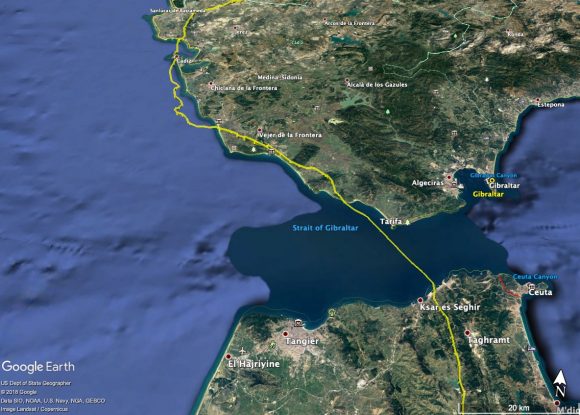Carr set out on his first autumn migration early on 1st September. He made fast progress south and crossed the First of Forth to the west of Edinburgh at 13:30. He continued flying until around 18:00 when he settled to roost in a wood to the north of Langholm in the Scottish Borders having flown 254 km.
Next morning he left his roost at around 07:30, but didn’t fly far. An hour later he was perched beside the Smithy Sike River and he remained in the area for the next two days. Perhaps he caught his first fish since leaving his nest site?
After two days in the Borders, Carr resumed his migration on the morning of 4th September, passing to the east of Carlisle at 08:15 and then continuing on a south-easterly track. By midday he was flying south through the Yorkshire Dales, climbing up to an altitude of 833 metres. At 13:30 he was fishing in Lumley Moor Reservoir and he spent the rest of the afternoon in the area – perhaps eating a fish?
Next morning Carr began migrating around 06:35 and he passed over Harrogate at an altitude of 327 metres 20 minutes later. At 07:20 he was 230 metres above Leeds and he continued to make good progress south during the course of the morning, passing just to the east of Sheffield before skirting around the west of Nottingham at 10:15 at an altitude of 488 metres. He was flying with a strong tailwind and it showed. He made fast progress through south-west through the Midlands and by 15:39 he was passing to the east of Salisbury in Wiltshire. He showed no signs of letting up and at 16:54 he crossed the mouth of Poole Harbour at 758 metres and then, ten minutes later, he headed out into the English Channel over Swanage. He maintained the same south-westerly course for 140 km over the sea before arriving on Guernsey at 20:30 and roosting beside Saint Saviour Reservoir after a day’s flight of 550 km.

Carr flew 148 km across the English Channel from Swanage to Guernsey.

Carr flew 550 km on 5th September
On 6th September Carr began migrating at 07:30 and flew 120 km across the sea to the Brittany coast, making landfall at Mont Saint Michel. From there he continued south-south-west, passing over Rennes at 13:36 at an altitude of 831 metres. An hour later he was perched in a large block of forest 25 km south-west and he remained there for the rest of the day.
Carr set-off again just before 9am next morning and at 12:27 he reached the Atlantic coast, flying over the island of Noirmoutier at an altitude of 113 metres. Many Ospreys follow the French coast as they migrate south, but Carr simply continued south, necessitating a long flight over the Bay of Biscay. The 411 km flight took just under 12 hours, with Carr finally making landfall on the Spanish coast west of San Sebastian after midnight. An excellent flight for a juvenile Osprey on its first migration.

Carr took 12 hours to fly over 400 km across the Bay of Biscay
Once in Spain, Carr used a route favoured by many Ospreys as they head south – flying through the centre of the country. He passed just to the east of Madrid during the morning of 10th September and crossed the Sierra Morena Mountains in northern Andalusia later that day. He eventually settled to roost 35 km south of Seville having flown 504 km that day alone.

It took Carr just over three days to fly through Spain.
Next morning Carr continued south-west to the coast and at midday local time he flew over Cadiz Harbour – an excellent place for Ospreys to stop-over or even spend the winter. Carr, though, showed no signs of letting up and he followed the coast south-east. At 14:42 he was 12 km north-west of Tarifa and he headed out across the Strait of Gibraltar towards Morocco, flying at altitudes of less than 100 metres during the course of his 28 km crossing. He reached Africa airspace at 15:15 and continued flying south until just after 20:00, covering a further 183 through northern Morroco before roosting in riverside trees north of the village of Sidi Kacem. He is now over 2500 km south of Carrbridge, just 11 days after leaving Scotland.

Carr made a 28 km crossing of the Strait of Gibraltar.
To see a map of Carr’s migration so far, click here.


















